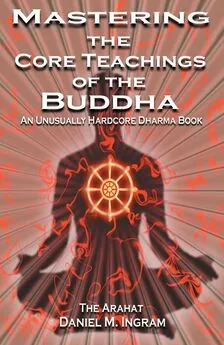Daniel Ingram - Mastering the Core Teachings of Buddha - An Unusually Hardcore Dharma Book
- Название:Mastering the Core Teachings of Buddha - An Unusually Hardcore Dharma Book
- Автор:
- Жанр:
- Издательство:Aeon Books
- Год:2009
- ISBN:9781904658405
- Рейтинг:
- Избранное:Добавить в избранное
-
Отзывы:
-
Ваша оценка:
Daniel Ingram - Mastering the Core Teachings of Buddha - An Unusually Hardcore Dharma Book краткое содержание
Mastering the Core Teachings of Buddha - An Unusually Hardcore Dharma Book - читать онлайн бесплатно полную версию (весь текст целиком)
Интервал:
Закладка:
It has become almost taboo to mention actual attainment or mastery of this stuff among many meditation communities, and this is grossly unfortunate, which is to say it is completely ridiculous and frighteningly ironic. Some reasons for this will be touched on occasionally, as well as some of what might be able to be done about this. However, if we are to have a clear standard for whether or not these techniques and teachings are working for us, it is vital that we have a thorough knowledge of what is possible and even expected of those who really practice well. That is the primary reason for Part III. Remember, you are reading a book called Mastering the Core Teachings of the Buddha. It has been written on the assumption that its readers actually want to do this.
That said, there will probably be readers who will think that most of what is written in Part III, which details the stages of enlightenment, the high concentration attainments, and even more unusual territory, is pure fantasy, myth, dogma and nonsense. I have little to say to these readers except that this book is obviously not written for them.
I hope that you will realize the difficulties inherent in language, concepts, doctrines, and maps of spiritual terrain. They are particularly clumsy tools even when used to their fullest potential, and this is unlikely to have happened here. Despite the fact that I will often use a tone implying certainty, it should be said that nothing whatsoever that I have written here is absolutely true. Language at its best is a useful tool, though by its very nature it artificially divides, reduces and over-simplifies. Hopefully, one will concern oneself with what is pragmatic rather than what is absolutely correct from some arbitrary point of view.
90
Introduction to Parts II & III
The crucial thing is practice and direct experience for one’s self. Once you understand for yourself, you will be able to laugh knowingly at my efforts.
91
13.BUDDHISM VS. THE BUDDHA *
One of my teachers once commented, “Buddhism and the
teachings of the Buddha have been at odds for 2,500 years!” These are cynical but appropriate words. What the Buddha taught was really extremely simple and, as a practice, particularly unglamorous and generally quite difficult though manageable. If one has a chance to read the original texts, one sees again and again that what the Buddha taught was generally practical and as non-dogmatic as could be expected. He basically said, “Do these very specific things, and these specific results will happen.” He had little use for ritual, ceremony or philosophy that was not for some practical purpose.
Now, it is true that things did get a bit more complex and religious in the later years of his teaching as The Vinaya, or code of conduct for monks, was established. The Buddha said that the added rules and regulations were a response to the increased quantity of low-quality students with whom he had to work in the later years of his life and the problems inherent in running a large organization. After the Buddha died, however, the process of turning the teachings of the Buddha from a practical path for awakening into a number of ritualistic religions reached new extremes of dogma and division. It is also true, however, that many worthwhile and practical variations on the fundamental teachings and techniques have been added that have provided great benefit to many of those who actually followed them rather than just talked about them.
In general, as mystical teachings become religions, all sorts of things get added on to them depending on the prevailing cultural norms, the current government’s attitude towards the teachings, how well or poorly the teachings are understood by those teaching them, and economic pressures. Christianity as a dogma (rather than as a mystical tradition or set of spiritual practices, e.g. sitting in the desert for 40 days, facing one’s demons, and finding God) is a just one scary example of this, but perhaps no scarier than the religions of Buddhism. Just as Christianity often seems to have little to do with what Jesus was talking about (and practically nothing to do with doing the practices he did or living the kind of life he did) just so Buddhism often seems to have largely forgotten about the core teachings of the Buddha. As Buddhism enters
Buddhism vs. The Buddha
America, a whole new layer of cultural dust is being added to it, most of which is related to the shadow sides of Western psychology and those of the New Age movement. However, there are also signs that fresh new life and health is being breathed into aspects of Buddhism that had become somewhat moldy and calcified in their countries of origin.
The extra trappings are not necessarily all harmful in and of themselves, but they may dilute the amount of practical information about how to awaken with all sorts of other information that may have little to do with awakening and may even be an impediment to it. This may then lead to less than complete emphasis on the three fundamental trainings in morality, concentration and wisdom, which are quite a handful and a great undertaking even in their most simple forms. I was extremely lucky, in that I learned some great Buddhist meditation technology long before I really got to know the culture of mainstream Western Buddhism. I have much use for the former, and as for the latter, well, read on.
It is true that Buddhist training can take on many valid forms, and this is a fine and beautiful thing, as different training methods may be appropriate for different meditators at different times. The added
“padding” of tradition and religion can be a comfort and a support, as most people seem to really like having some kind of dogmatic, mythical or cultural foundation from which to work.
Traditions and standardized conceptual frameworks can also
provide the means by which people can talk to each other about experiences and techniques that might otherwise be very hard to explain clearly. I have a friend from another mystical tradition who knows much that I find useful and interesting, but it took us months to even begin to line up our terminology so that we could benefit from each other’s understanding.
However, these conceptual frameworks and trappings may also
produce the huge amount of useless, harmful and divisive sectarianism that exists within Buddhism and between the various meditative or mystical traditions, as well as all sorts of effort going into things that produce no freedom and may cause other forms of suffering.
Every time I leave my sheltered little academic life and enter the rough and tumble world of endlessly petty, sectarian dharma scenes, I 93
Buddhism vs. The Buddha
am again astounded at how fixated people can be on the minute differences between their tradition and traditions that are so similar to theirs they can only be differentiated by the clothes people wear and the names they call things. I can’t tell you how tiring it is. Sometimes I wonder how these otherwise kind and reasonable people can stand themselves or each other when they are like that. We all want to be special, but I beg you, find a way to be special that allows others to be special also. It is what is common to the great mystical paths that makes them special. The differences are 100% guaranteed to be fundamentally irrelevant. Now, that said, I am going to turn around and bust on cultural aspects of traditions that are not into awakening and mastering what the Buddha was talking about. This is Buddhism, after all, and so it seems only natural that I should be into what the old boy was into.
I have heard way too many conversations between members of
differing mystical traditions that could be summarized, “My dogma and ideals are better than your dogma and ideals.” Even worse are the rare and astonishing conversations that might be summarized, “My dogma and ideals are better than your actual realizations and profound insights.” Frightening.
There is a movement in the West, reminiscent of the original objectives of the Buddha in the early days of his teaching, to divorce Buddhism’s core meditation technology and basic trainings from religion and ritual entirely. I am a great fan of this movement, so long it does not cause people to throw out too many of the original Buddhist conceptual frameworks that are helpful as tools for mastering these practices. There is also a movement in the West to take the meditative technology of Buddhism and integrate it into everything from Catholicism to psychiatry to the freakish fringe of the New Age. I don’t have a problem with this trend particularly, just as long as people realize that you could just as easily divorce these technologies from those traditions and have something that is still very useful and powerful.
There is another related movement in the West, and that is to make Buddhism into something for everyone. Unfortunately, what is happening is that Buddhism is becoming watered down in order to make it have broad appeal. The result is something very similar to what happens in places like Thailand, where most people “practice 94
Buddhism vs. The Buddha
Buddhism” in a way that is largely devotional and dogmatic. In the West, this translates to people “practicing Buddhism” by becoming neurotic about being Buddhist, accumulating lots of pretty books and expensive props, learning just enough of some new language to be pretentious, and by sitting on a cushion engaged in free-form psychological whatnot while doing nothing resembling meditative practices. They may aspire to no level of mastery of anything and may never even have been told what these practices were actually designed to achieve.
Thus, their meditation is largely a devotional meditation, something that externally looks like meditation but achieves little. In short, it is just one more spiritual trapping, though one that may have some social benefits. Many seem to have substituted the pain of the pew for the pain of the zafu with the results and motivations being largely the same. It is an imitation of meditation done because meditation seems like a good and noble thing to do. However, it is a meditation that has been designed by those “teachers” who want everyone to be able to feel good that they are doing something “spiritual”. While it is good for a person to slow down to take time out for silence, I will claim that beyond these and a few cardiovascular benefits there is often not a whole lot of any great worth that comes from this sort of practice. True, they are not out smoking crack, but why get so close to the real thing and then not do those practices that make a real difference?
Many will consider my devaluation of low-grade sitting practice radical and counterproductive. Perhaps it is, but I claim that many who would have aspired to much more are being short-changed by not being invited to really step up to the plate and play ball, to discover the profound capabilities hidden within their own minds. This book is designed to be just such an invitation, an invitation to step far beyond the increasingly ritualized, bastardized, and gutless mock-up of Buddhism that is rearing its fluffy head in the modern West and has a strangle hold on many a practice group and even some of the big meditation centers.
To be fair, it is true that spiritual trappings and cultural add-ons may, at their best, be “skillful means,” ways of making difficult teachings more accessible and ways of getting more people to practice correctly 95
Buddhism vs. The Buddha
and in a way that will finally bring realization. A fancy hat or a good ritual can really inspire some people. That said, it is lucky that one of the fundamental “defilements” that drops away at first awakening is attachment to rites and rituals, i.e. Buddhism, ceremony, specific techniques, and religious and cultural trappings in general.
Читать дальшеИнтервал:
Закладка:





![Дженнифер Гюнтер - The vagina book. Главная книга для тех, у кого есть этот орган [litres]](/books/1061538/dzhennifer-gyunter-the-vagina-book-glavnaya-kniga-dl.webp)




